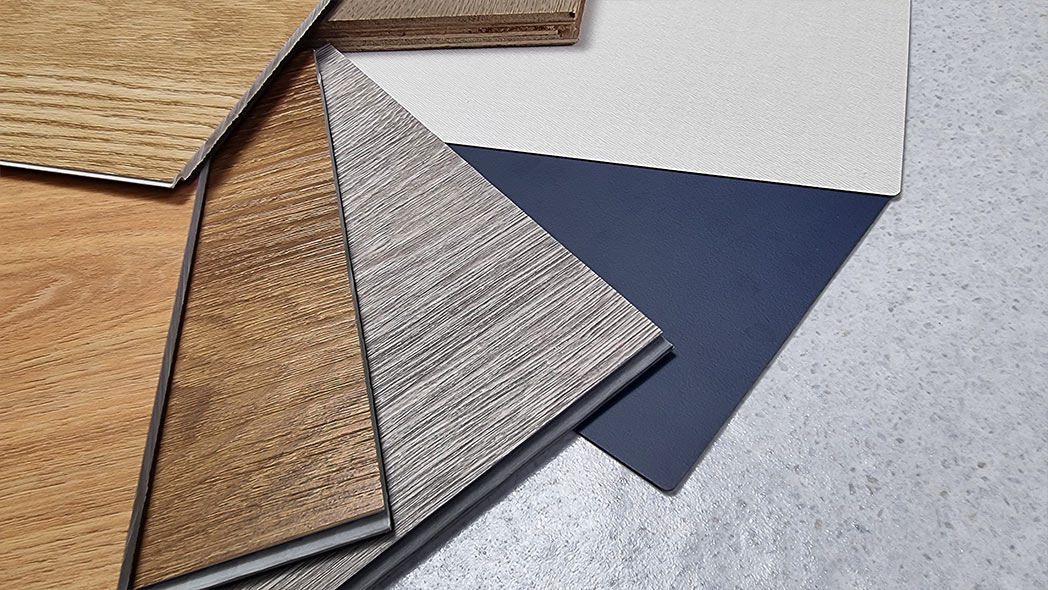
Foto: Wongsakorn Dulyavit
Vinyl is a versatile material used in various aspects of daily life. It is particularly popular as a flooring option due to its durability, resilience, and ease of maintenance. In this guide, you'll learn everything you need to know about vinyl, from the basics and properties to the different types of vinyl flooring and design flooring. This guide will cover all the essential information about vinyl, from its fundamental properties to the different types of vinyl floors. Additionally, we'll delve into the differences between vinyl and design floors.
Content
Definition and Composition of Vinyl
Vinyl, also known as PVC (Polyvinyl Chloride), is a type of plastic that is exceptionally versatile and useful. It is produced by combining small chemical building blocks, known as vinyl chloride monomers. Vinyl is highly durable, copes well with moisture, and can easily be shaped into various forms. These properties make vinyl a favoured material for a multitude of applications, including flooring.
The uniqueness of vinyl (PVC) lies in its ability to melt when heated and solidify when cooled. This property allows the plastic to be molded into numerous different shapes. PVC is found in two main forms: rigid PVC and flexible PVC. Both rigid and flexible PVC may contain plasticizers. The difference lies in the amount and type of plasticizers used. Flexible PVC generally has a higher proportion of plasticizers than rigid PVC.
- Rigid PVC is used for products like window frames, pipes, or records.
- Flexible PVC is used for items such as cable insulation, hoses, or truck tarpaulins.
Vinyl flooring can essentially be made from either rigid or flexible PVC, depending on the specific application and desired properties of the flooring. The use of plasticizers in vinyl floors has led to health and environmental concerns in the past. In response, phthalate-free plasticizers have now been developed, offering a safer and more environmentally friendly alternative. Modern vinyl flooring products, offered by manufacturers like planeo, forgo the use of harmful plasticizers. These innovations contribute to vinyl floors being valued not only for their practical benefits but also for their improved environmental and health compatibility.
History and Development of Vinyl
Vinyl (PVC) was first synthesized at the end of the 19th century, but its commercial development and practical application began in the 1920s and 1930s. Initially introduced as a replacement for natural products like rubber and cork, vinyl quickly gained popularity thanks to advancements in manufacturing technology. These advancements made vinyl more flexible, durable, and versatile in its application, leading to its widespread use in numerous products and industries. Improvements in polymerization processes and the introduction of additives have made PVC one of the most versatile plastics in use today.
Waldo Semon, an American researcher, played a key role in the development of PVC by making it more flexible and practically usable in the 1920s. He produced the first products from this material, including golf balls and shoe heels. Today, vinyl is the second most produced plastic in the world and is used in a wide range of applications.
Advantages of Vinyl Compared to Other Materials
Vinyl stands out for its many advantages over other materials, making it a popular choice for various applications, especially as flooring. It is durable, resilient, and offers exceptional resistance to moisture, dirt, and chemicals, making it ideal for areas like kitchens and bathrooms. Compared to wood, vinyl is less susceptible to warping, mold, and insect infestation, while it is lighter and more resistant to corrosion compared to metal. Besides its easy cleaning and maintenance, vinyl can mimic the appearance of more expensive materials like wood or stone without their cost and upkeep. Vinyl floors also provide the comfort of warmth underfoot and have sound-dampening qualities, making them a practical and aesthetically pleasing option for living and workspaces.
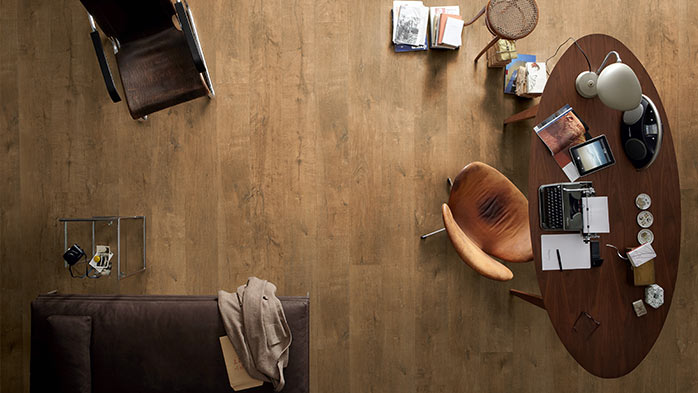
Vinyl Flooring: Composition and Variety
Vinyl floors, due to their versatility and robustness, are an excellent choice for nearly any living space. There are primarily three types of vinyl floors: solid vinyl, vinyl on HDF (High-Density Fiberboard) backing, and Rigid Vinyl (SPC Vinyl).
Solid vinyl is characterised by a continuous, mostly homogenous vinyl layer that is directly laid on the substrate and often fixed by clicking or gluing. This option offers easy handling and is known for its durability.
Vinyl on HDF backing consists of a high-density fiberboard base with a vinyl layer applied on top. This combination allows for stable and comfortable installation through a click system, providing not only stability but also increased walking comfort.
Rigid Vinyl or SPC Vinyl represents an innovative addition to the range, featuring an especially robust backing plate that does not complicate installation. This flooring is known for its extreme robustness, ease of maintenance, and versatile design options and is often used in areas requiring high durability.
The structure of each vinyl floor is comprised of several layers, together offering impressive resistance to daily stresses.
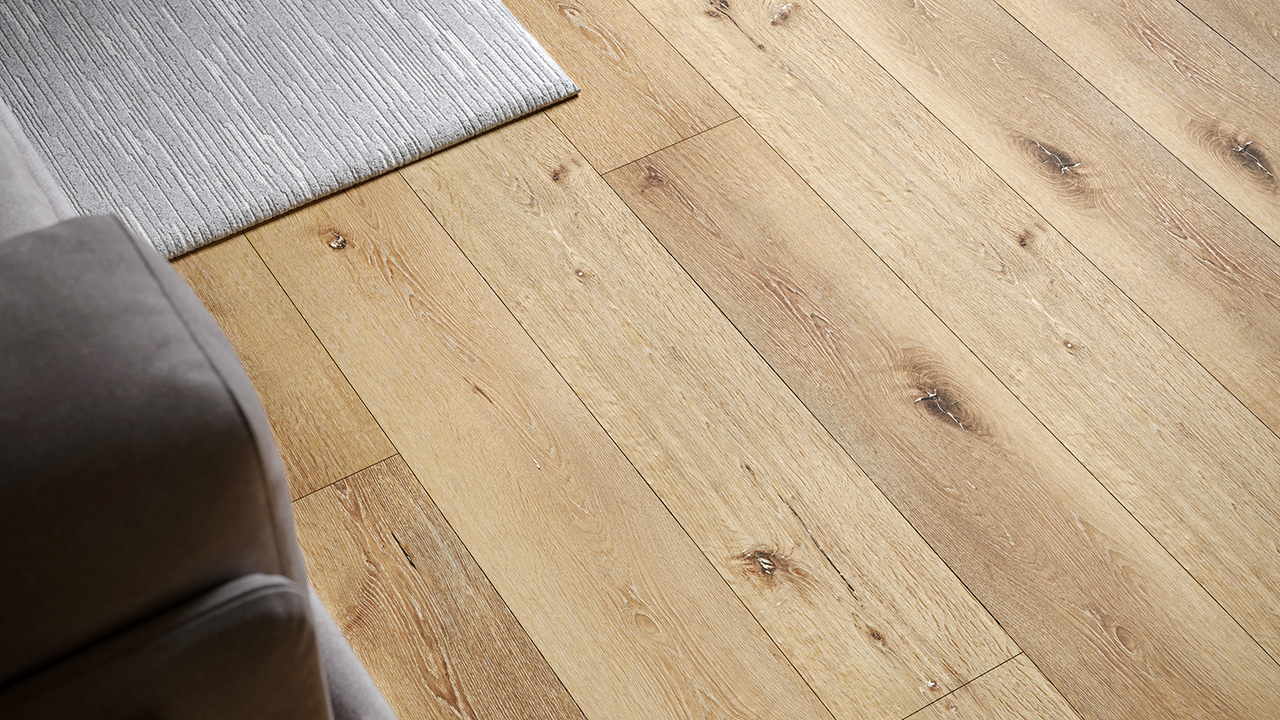 planeo Rigid Vinylboden Eiche Naturbraun - Trittschall integriert
33,90 € pro m²
planeo Rigid Vinylboden Eiche Naturbraun - Trittschall integriert
33,90 € pro m²
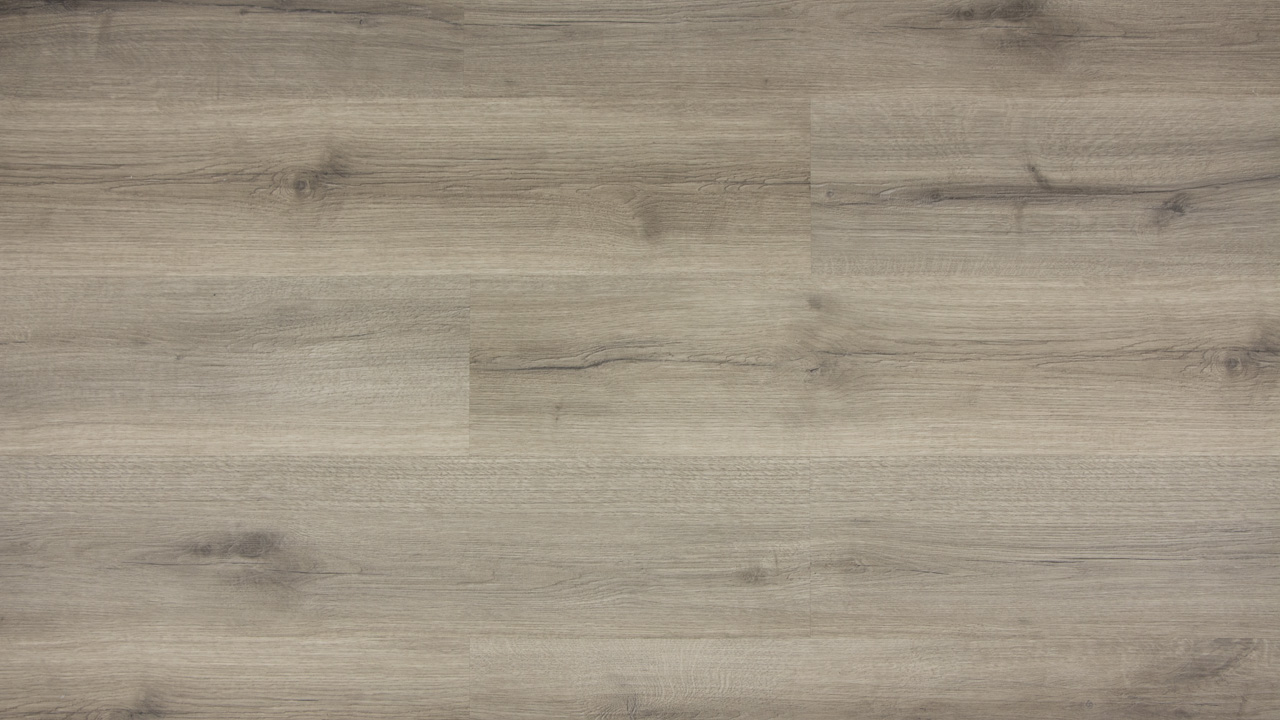 planeo Click vinyl - Rigid cracked oak greige | waterproof (RS7337)
14,90 € pro m²
planeo Click vinyl - Rigid cracked oak greige | waterproof (RS7337)
14,90 € pro m²
Solid vinyl
- Single, homogenous vinyl layer: Continuously made of vinyl for direct laying on the substrate, mostly by clicking or gluing.
- Decor layer: Digital photo prints that imitate wood, stone, or tiles, giving the floor its specific appearance.
- Wear layer: A transparent surface protecting the decor of the floor from wear, scratches, and stains.
Vinyl on HDF backing
- Carrier layer: High-density fiberboard (HDF) as the base.
- Vinyl layer: Applied to the HDF layer, often with a click system for easy installation.
- Decor layer: Provides a realistic look through digital photo prints that mimic natural materials like wood or stone.
- Wear layer: A transparent surface for protection against wear, scratches, and stains.
Rigid Vinyl (SPC Vinyl)
- Carrier layer: Highly robust, made from a mix of limestone and plastics, offering stability.
- Decor layer: Digital photo prints that imitate wood, stone, or tiles.
- Wear layer: Clear protective layer against wear and damage.
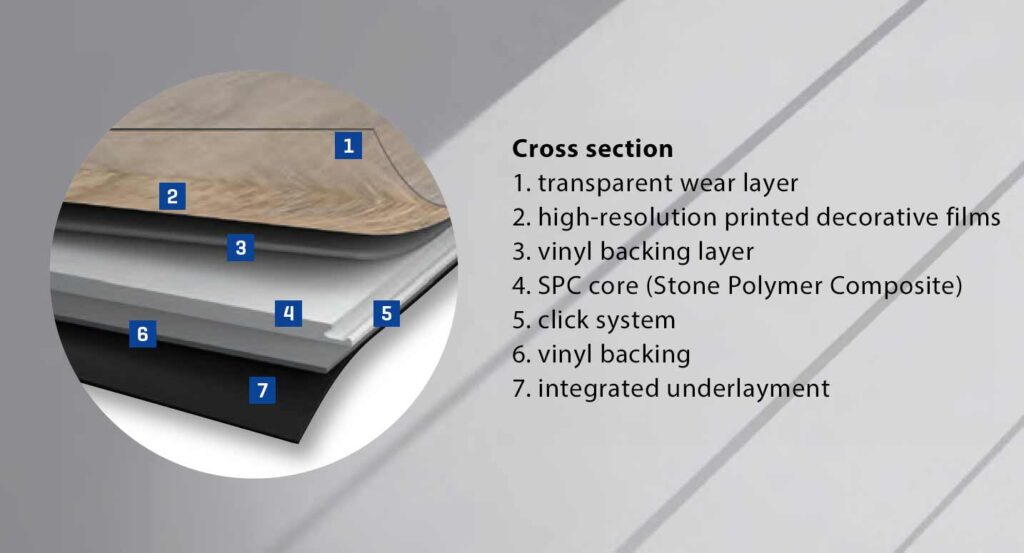
With a variety of designs and surface textures, vinyl flooring enables the realization of individual living dreams in wood, stone looks, or creative patterns, without compromising on quality and durability.
Differentiation Between Design Flooring and Vinyl Flooring
The terms overlap in that vinyl floors can fall under the category of design floors, but not every design floor is made of vinyl (PVC). In short, while all vinyl floors can be considered design floors, not all design floors are made of vinyl. Both options offer a wide range of décors and photo-realistic designs, including wood, stone, and tile looks, which are nearly identical to their natural counterparts thanks to modern printing techniques.
What is Vinyl Flooring?
When comparing vinyl and design floors, the main difference lies in the materials and marketing use. Vinyl floors are specifically made from Polyvinyl Chloride. They are known for their cost efficiency, robustness, and ease of maintenance and are available in various forms like tiles, sheets, planks, or rolls (PVC flooring). In the past, vinyl floors were criticized for the use of harmful plasticizers and phthalates. However, there are now a variety of vinyl floors that are phthalate-free and use environmentally friendlier plasticizers, improving their environmental and health compatibility. For example, the vinyl floors from planeo offer such an eco-friendly option. Additionally, other well-known manufacturers provide phthalate-free vinyl floors, significantly expanding the choices for consumers who value sustainability.
What is Design Flooring?
On the other hand, design flooring is a broader term that includes aesthetic surface floorings made from a variety of materials, not just vinyl (PVC), but also PET, PP, and even more eco-friendly options like Polyurethane (PU) or Polyolefins, which are partly made with renewable resources such as castor or rapeseed oil for plasticizers. The term "design flooring" has also established itself as an effective marketing term, emphasizing the aesthetic diversity and technological innovation of these floorings, although it encompasses a much wider variety of materials than just vinyl (PVC). This marketing strategy aims to highlight the exclusivity and design potential of the products, but it can be confusing for consumers, as the term is not legally protected or clearly defined.
Different Types of Vinyl and Design Flooring
The world of vinyl and design floors offers an impressive variety of types and installation methods to meet a wide range of requirements and design desires. Among the most popular variants are click vinyl and adhesive vinyl, which differ in their installation methods and applications.
Design and Vinyl Floors for Clicking (Click Vinyl)
These floors are known for their easy and quick installation. Thanks to an innovative click system, the planks can be connected without adhesive, allowing for a floating installation. This method is especially suitable for DIY enthusiasts and allows for easy disassembly if necessary. Click vinyl is ideal for rental properties or rooms where a quick renovation is desired without damaging the existing floor.
Adhesive vinyl (Adhesive floor tiles)
In this variant, the vinyl floor is fully glued to the substrate. It offers greater stability and is suitable for heavily trafficked areas, although the installation is more complex for several reasons. Firstly, the substrate must be carefully prepared for installation to ensure optimal adhesion. This usually involves priming and smoothing the base surface to eliminate irregularities and dust that could affect the adhesive strength. An improperly prepared substrate can lead to bubbling, detachment, or uneven wear.
Furthermore, full-surface gluing requires precise work, as the flooring is directly and permanently connected to the substrate. Errors in alignment or application cannot be easily corrected without damaging the material or wasting it. Additionally, the adhesive must be applied evenly to achieve consistent adhesion and a smooth final result.
Despite these challenges, glue-down vinyl is often used not only in commercial areas or in rooms with intensive use due to its high stability and resistance to moisture and heavy loads but also in private areas. Investing in professional installation pays off in the long term through the floor's durability and resilience.
Optical Design Options and Styles
Vinyl and design floors offer an almost limitless palette of optical design options and styles, allowing for the realization of individual living dreams:
- Wood looks: From classic oak to exotic teak, vinyl and design floors can mimic the warmth and elegance of natural wood floors. They are not only aesthetically pleasing, but also durable and easy to maintain.
- Stone and tile looks: Marble, slate, or ceramic tiles – these floors offer the look of stone and tiles with the comfort and warmth of vinyl.
- Modern and creative patterns: Geometric patterns, abstract designs, or even individual images and logos can be realized to set unique accents.
Thanks to advanced printing and embossing technology, these floorings provide an authentic texture and depth, allowing for the implementation of nearly any style and design concept, from classic to modern.
In addition to the appearance, various surface textures can also be chosen, such as a matte or glossy finish. The laying patterns can also vary, from simple, straight patterns to complex laying patterns like the herringbone pattern.
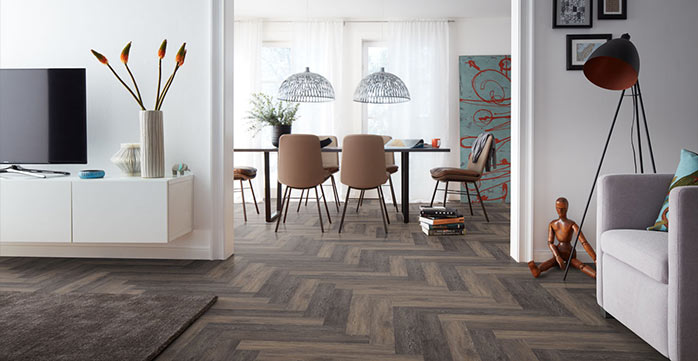
Conclusion
As a flooring option, vinyl offers an outstanding combination of style, durability, and ease of maintenance, making it the ideal choice for both your home and office. Vinyl flooring allows you to experience the natural beauty of wood or the elegance of stone without the associated high costs and maintenance effort. It presents an extensive selection of designs and surfaces, making every room vision a reality. Whether solid vinyl, vinyl on HDF backing, rigid vinyl, or glue-down vinyl – each variant brings specific advantages to meet different room needs. Additionally, concerns about harmful plasticizers have been largely addressed through the development and use of safe, phthalate-free alternatives, making vinyl floors an even more attractive option.
Experience the best service with planeo - because you need it!
No matter what challenges you face with your project, planeo provides you with the right solution. Benefit from the advantages of our services:
- Free samples for many of our products: Order up to 7 samples at no cost, for instance, of our vinyl floors, click vinyl, adhesive vinyl, or rigid vinyl.
- Express delivery - for urgent projects and quick decisions.
- Expert advice - We offer professional consultation through our contact page or answer your questions directly in the comments.